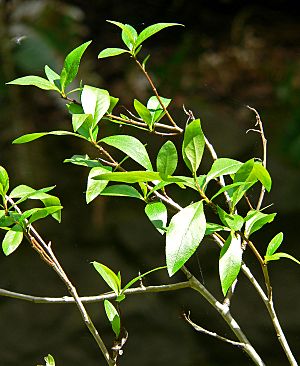Narrowleaf cottonwood facts for kids
The narrowleaf cottonwood (scientific name: Populus angustifolia) is a type of tree that belongs to the willow family (Salicaceae). It grows naturally in western North America. You can often find it in the Rocky Mountains and the flat lands around them. This tree grows as far north as Alberta and Saskatchewan in Canada. It also grows south into parts of Mexico, like Chihuahua, Coahuila, and Sonora. Narrowleaf cottonwoods usually live near streams and creeks. They prefer places that are between 3,900 and 7,900 feet (1,200 to 2,400 meters) high.
Quick facts for kids Narrowleaf cottonwood |
|
|---|---|
 |
|
| Scientific classification | |
| Genus: |
Populus
|
| Species: |
angustifolia
|
 |
|
| Generalized natural range of Populus angustifolia | |
Contents
What Does This Tree Look Like?
The narrowleaf cottonwood tree has a slender shape. It can grow very close together in groups, almost like a fence of trees. Its leaves are a bright yellow-green color. They are shaped like a spear or a lance, which is why they are called "lanceolate." The edges of the leaves are wavy or scalloped.
In the early spring, this tree grows special flower clusters called catkins. These catkins later turn into fluffy, white seed capsules. These capsules help the tree spread its seeds.
How Cottonwoods Mix and Grow
Sometimes, different types of trees can mix their genes. This is called hybridization. The narrowleaf cottonwood can easily mix with other cottonwood trees. These include the Populus balsamifera, Populus deltoides, Populus fremontii, and Populus trichocarpa.
When these trees mix, they can create many new trees that are a blend of both parents. For example, the mix between the narrowleaf cottonwood and the eastern cottonwood was once thought to be a completely new species. Scientists even gave it a different name, "P. acuminata." But in the 1980s, they discovered it was actually a hybrid, meaning it was a mix of two different cottonwood types.
What Are Narrowleaf Cottonwoods Used For?
The buds of the narrowleaf cottonwood tree are sticky and gummy. Long ago, Native American peoples, like the Apache and Navajo, enjoyed chewing on these buds. It was a bit like their own natural chewing gum.
This tree is also a home for a tiny insect called the sugarbeet root aphid (Pemphigus betae). These aphids live on the tree and feed on its sap.
See also
 In Spanish: Populus angustifolia para niños
In Spanish: Populus angustifolia para niños


